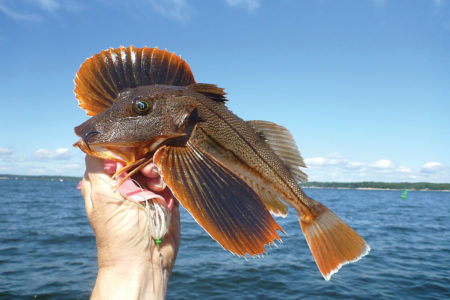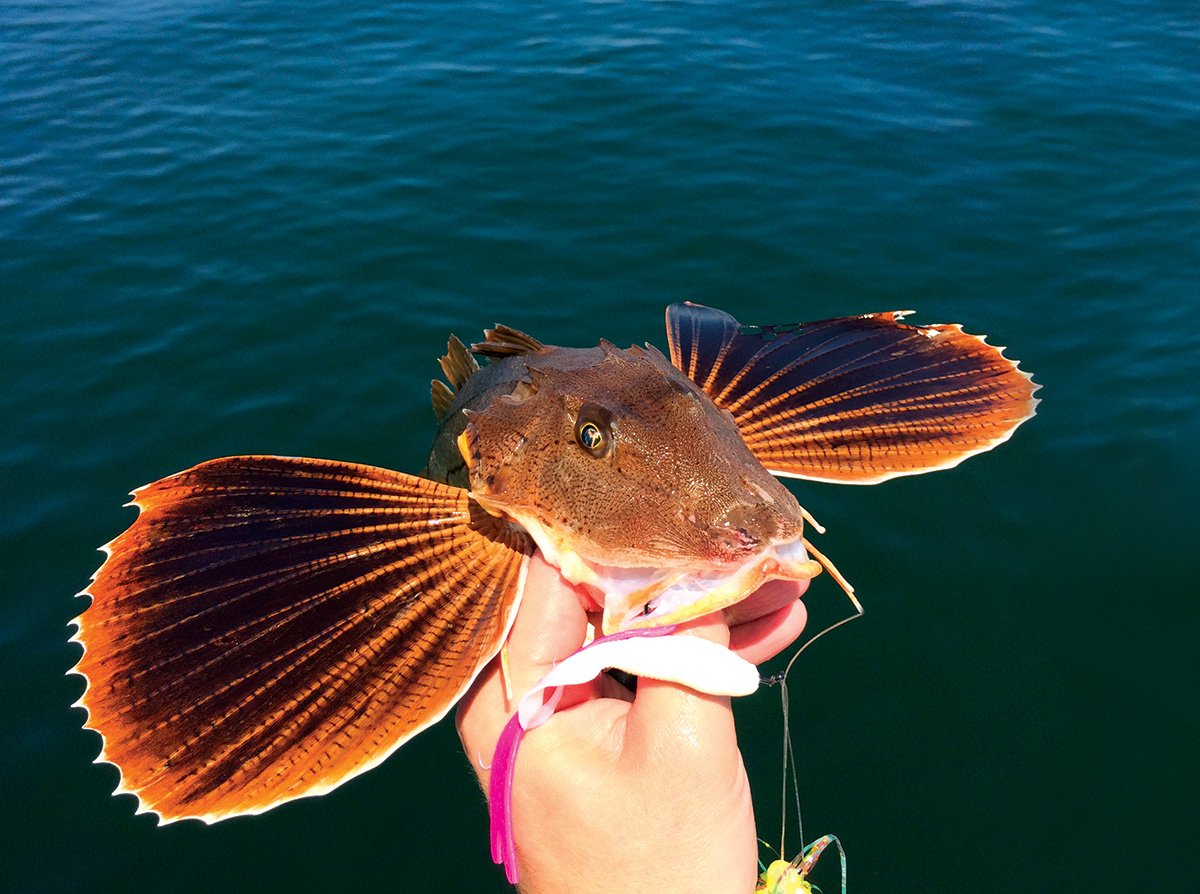
With its mild taste, abundance in local waters and eager willingness to take a baited hook, the sea robin could be the perfect inshore target species.
If you’re anything like the way I used to be, then you quite likely regard the striped sea robin (Prionotus evolans) as little more than a nuisance fish. If you enjoy hunting doormat fluke then you might welcome the occasional sea robin in that they can be turned into some excellent strip baits, but find too many of them and you’ll be cursing their existence and preparing to make sacrifices to the fish gods in exchange for their exodus. While I don’t personally know of anyone live-lining them for stripers on a regular basis, it is well-documented that cow bass feed upon this common bottom-dweller. But there has to be more to these “birds” than just bait options for more desirable species, right?
My sea robin evolution occurred a few years ago after watching an episode of Bizarre Foods on The Travel Channel that was set in Rhode Island. In it, Chef Matt Jennings of Farmstead Inc. in Providence, RI prepared several meals for host Andrew Zimmern with so-called, “less desirable” species of local fish including mackerel and sea robin. I was surprised at how simple the preparation of the sea robin appeared to be, and the end product looked extremely appetizing, even for a general non-fish-eater such as myself. I also figured that I was pretty good at catching them when targeting other local bottom species like scup, fluke and sea bass, so it might be an excellent way to take advantage of an untapped bounty.
A few weeks later was my August vacation, and as part of my week away from work my wife and I met up with several of our friends for a day of fishing followed by our annual meal of eating off the land. The goal of this feast was to source as much of the food locally whether it be vegetables or protein, and some fresh-caught fish including scup, sea bass, blackfish and fluke generally made its way to the table. If I was feeling ambitious then I’d also make it a point to dig some fresh cherrystones for myself. If nothing else it always ended up an enjoyable and extremely tasty dining experience! Well, with the Bizarre Foods episode fresh in my mind, I added four sea robins to the menu, which we caught while targeting scup off the beach. I prepared the fillets in the exact same way I had seen Chef Jennings prepare them, and everyone was blown away at how good they were.
Cleaning & Cooking
The method I learned on that episode of Bizarre Foods resembles a common preparation of the fish simply referred to as “gurnard.” In Europe, the gurnard has become a much more popular food fish in recent years after spending much of its existence relegated to lobster bait. (Does this sound familiar?) Gurnard and sea robin are common along both coasts of the Atlantic and therefore make excellent target species. While I have seen and even attempted to fillet sea robins in a more traditional round-fish manner in the past, the method to follow is far and away simpler and results in much less waste. Begin by cleaning the outside of the fish, removing any excess slime that may have accumulated. If you have a cut-proof kitchen glove handy then I suggest using it as the head of the sea robin will do a number on your hands! I have even coined the term, “sea robin hand” which results in attempting to fillet several of these spike-and-bone-covered fish without the aid of said glove. Envision a case of “striper thumb” but it covers your entire palm.
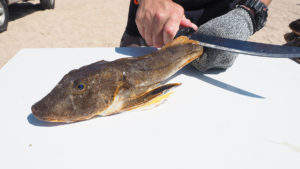 1
1
Dry the fish and place it on your cutting board, belly down, and begin to “shave” a strip off the back of the fish.
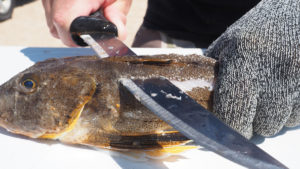 2
2
The goal here is to remove the dorsal fins by essentially filleting them from the rest of the fish. This step can be accomplished either with a knife, or with a set of heavy-duty kitchen scissors. A fillet knife works okay but I prefer a rigid kitchen knife.
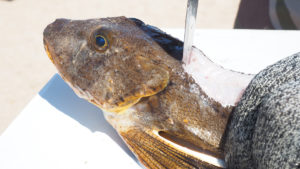 3
3
Once the dorsal fins are removed, take a knife and insert the point into the spine from above, breaking through the bone but not cutting completely through the fish. A pair of heavy-duty kitchen shears may again be used here, but be forewarned that the spine is very hard and I have broken several scissors at this stage.
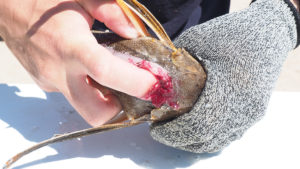 4
4
Once the dorsal fin is removed and the spine cut, grasp the fish’s head in your gloved hand and the body in the other hand. Insert your fingers inside the body cavity behind where you cut the spine and bend the fish in half,
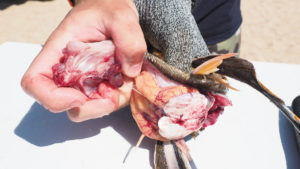 5
5
pulling the meat in one hand out and away from the skin and head in the other hand.
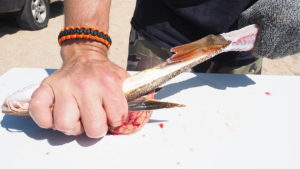 6
6
The meat should pop out and you literally peel the meat out of the skin down to the tail, leaving the head, guts and skin attached in one hand and the meat/spine in the other hand. For those of you familiar with skinning an eel or even a catfish, the process is somewhat similar.
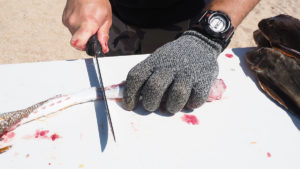 7
7
You’ll need to cut the tail off if the skin didn’t peel over the fin—I’m usually good for one out of four requiring the knife. Clean any remaining skin or guts from the fillet and you can either leave the fillets attached to the spine (my preferred method) or you can fillet the meat off the bone per traditional fish-filleting methods. It usually takes two or three sea robins per person for a good meal depending on fish size, side dishes and appetite, but I advise preparing a few more than you think you’ll need as there has never been any leftovers when I have prepared them.
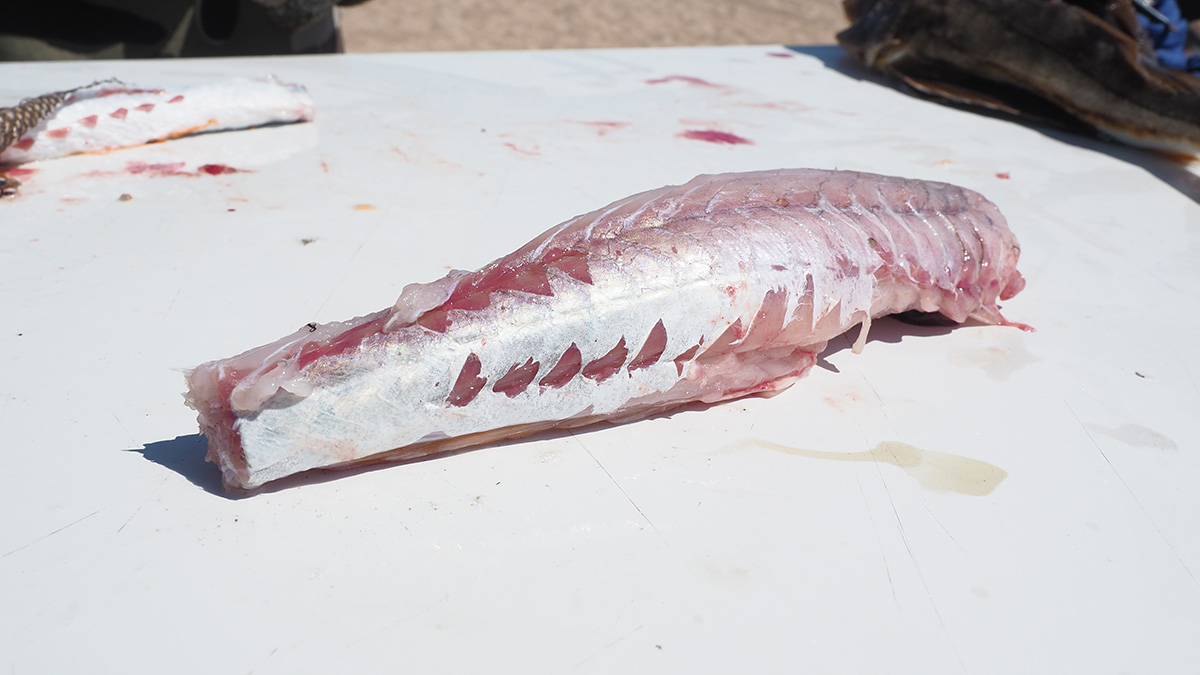
Applying Some Heat
Once all the fish have been filleted, cooking them is even simpler than the fillet job. Again, as was done on Bizarre Foods, I stick to how I learned originally and find that simply browning the meat in a pan of melted butter followed by a few minutes in the oven to finish cooking is all that is needed. A little sea salt and pepper can be added to the fillets before cooking but it is not necessary. Once removed from the oven the meat will flake right off the spine and it has a mild taste with a light, flaky texture—just about perfect for someone like me who does not enjoy eating “fishy” fish. The brown butter from the cooking process makes for an excellent sauce. Alternately you could batter the fillets and fry them, stuff with seafood stuffing and bake or just about any other method of preparation that you see fit.
So there you have it; a simple way to turn one man’s trash fish into another man’s delicacy. With increasingly-restrictive bag limits and shortened seasons on many of the other more popular gamefish these days, the sea robin offers a great alternative. With its mild taste, abundance in local waters and near-unending willingness to take a baited hook, the sea robin could be the perfect inshore target species. Give it a try, you will not be disappointed!
| COOKING THE BIRD |
|---|
|
Once you have removed the skin, you will have the white meat tail section. You may cook it whole with the bone in, or you can fillet the meat off of both sides of the center bone. BONE-IN: FILLETS: |


